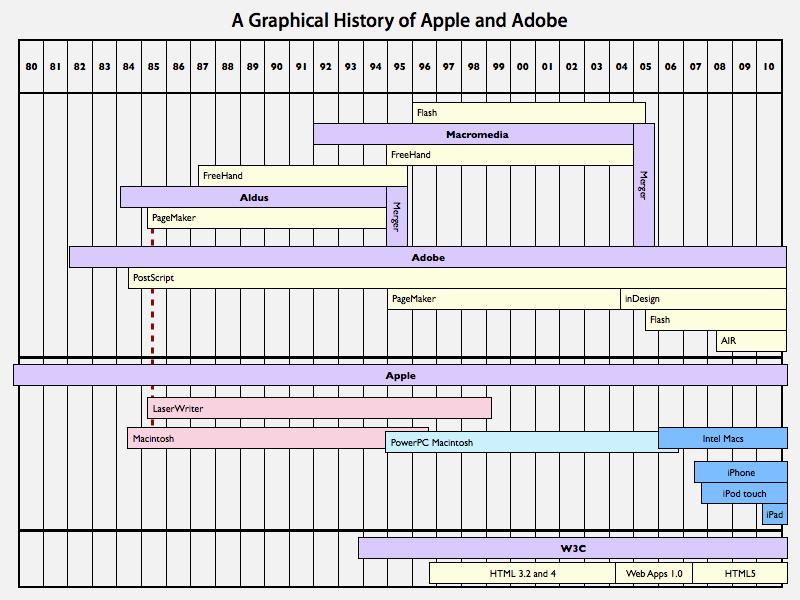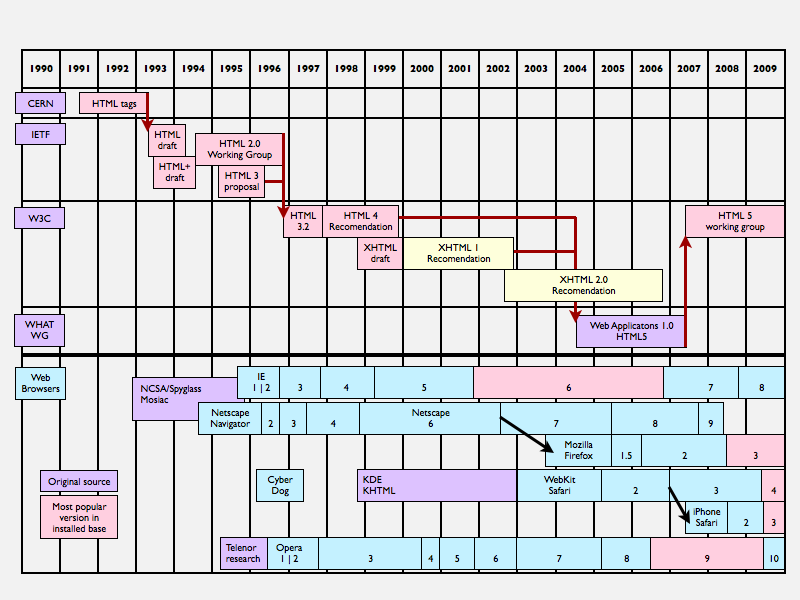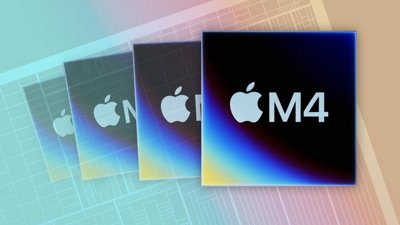The character of the attacks in today's Flash Wars seems extraordinary, but is certainly not unprecedented, as sources familiar with the events from two decades ago remind us. That's because this latest skirmish isn't the first time Apple has sent Adobe into wildly frothy hysterics due to a perceived jilting.
This All Happened Before
Back in the late 80s, Adobe had a very different software monopoly in place. Rather than controlling the platform for creating and delivering dynamic content on the web with Flash, Adobe was sitting upon PostScript, a platform for creating and delivering digital content via print.
PostScript was Adobe's original product, taken from Xerox PARC's hotbed of innovation and commercialized by company founders John Warnock and Charles Geschke. Three years after launching Adobe, Steve Jobs created a partnership with the company that licensed its PostScript page description technology to drive Apple's new LaserWriter, with Apple also investing $2.5 million in Adobe for a 15% stake in the company.
Paul Brainerd started a third company to pioneer this emerging desktop publishing market; it was named Aldus and its flagship product was PageMaker, running on Apple's Macs and using PostScript to create high resolution print output via the LaserWriter. Apple actually announced the LaserWriter on the same day Aldus unveiled PageMaker. Together, Apple, Aldus and Adobe created the emerging market for desktop publishing.
As a middleware platform, Adobe's PostScript became so essential to desktop publishing and the Mac that Adobe could charge pretty much whatever it wanted for the software and the "Type 1" fonts it used. In 1989, Apple's replacement for Jobs, Jean-Louis Gassée, approached Adobe seeking a cheaper version of PostScript for use on Apple's new low-priced Macs then in the product pipeline. Adobe refused. This prompted Apple to seek market-based solution to Adobe's greed: it began to investigate alternatives to PostScript.
Microsoft had acquired TrueImage, a PostScript clone that could replace Adobe's language in laser printers. Apple itself had developed an operating system font scaling technology it called TrueType, for drawing smooth fonts on the screen that could be rendered at high resolution on a printer. The two companies agreed to cross license their technologies to make both widely available across the Mac and Windows platforms, erasing any need for anyone to keep paying for Adobe's overpriced PostScript software and the Type 1 fonts it required.
Adobe's scorn, vilification and trash talking from 20 years ago
At the Seybold Desktop Publishing Conference in San Francisco on September 20, 1989, Apple and Microsoft jointly presented their new TrueType partnership. Adobe's Warnock was enraged. He publicly castigated Apple and Microsoft, saying, "That's the biggest bunch of garbage and mumbo jumbo," and speaking on the verge of tears, he emphatically added, "What those people are selling you is snake oil!"
The TrueType announcement seemed to eviscerate Adobe's future prospects. Apple dumped its holdings in Adobe as the company's stock price plummeted. Apple still ended up profiting $79 million on its original investment in Adobe, according to Jim Carlton's book "Apple: The Inside Story of Intrigue, Egomania, and Business Blunders."
Following the fallout between Apple and Adobe, Adobe rushed its new Adobe Type Manager to market to enable its Type 1 PostScript fonts to be used on the Mac desktop just like TrueType fonts. Adobe also eased up on its prices and negotiated with Apple new terms to keep PostScript on its LaserWriters. In the PC world, TrueType and PostScript-clone printers became more popular, despite being problematic, because they were cheaper. Apple's continued exclusive licensing of Adobe's PostScript for its LaserWriters eventually helped drive Apple out of the printer business as cheaper alternatives became available. Adobe's lock on desktop publishing with PostScript had been broken.
Adobe branches out into apps
Despite continuing to do most of its business with Apple, Adobe strengthened its position with Windows to hedge its bets in application software. It also began making efforts to build a portfolio of creative apps to join its own Illustrator drawing tool. It first eyed Aldus, which not only sold the popular PageMaker, but also sold a competitor to Adobe's Illustrator named FreeHand.
Adobe had earlier "unwittingly given a nearly free and unlimited PostScript license" to FreeHand, according to an early Aldus employee familiar with the events. Aldus FreeHand was now trouncing Adobe's Illustrator, so Adobe planned to buy Aldus in 1994 and simply erase its competitor in the market for professional drawing applications.
The problem, as Adobe later discovered, was that FreeHand wasn't actually owned by Aldus; Altsys, its developer, only sold the title through Aldus, so the deal couldn't take FreeHand off the market, much to Adobe's chagrin. FreeHand's developer subsequently sold itself to Macromedia in 1995, which became Adobe's primary competitor in digital creative apps over the next decade. Adobe wouldn't subsequently take FreeHand off the market until 2005, when it purchased Macromedia. That $3.4 billion deal also gave Adobe more than just creative apps: it gave it a new PostScript-like platform: Flash.
Incidentally, a reader adds: "freefreehand.org has been setup to recruit members and raise funds to try to convince Adobe through legal means to divest itself of FreeHand, which they are trying to let die a slow death. Fortunately this skirmish with Apple has helped shed a tad of light on how hypocritical Adobe is regarding 'healthy competition' and all the other drivel they are spouting regarding Apple spurning Flash."
On page 2 of 3: Flash takes over the web, Apple's changing stance on Flash.
Originally launched as an animation tool, Flash quickly became an easy way to add interactivity to multimedia projects (such as CD-ROMS), and eventually web pages. Its popularity on the web blossomed after Microsoft began bundling it with Internet Explorer 5 in 1999, spreading over the web just as PostScript had spread across laser printers in the 80s. Adobe's rival effort to promote open standards for web animation (including SVG) failed to gain traction in the face of IE's wide propagation of Flash.
Apple subsequently incorporated Flash 4 content as a track type in QuickTime 5, enabling developers to create movies with a layer of interactivity to control playback or perform other functions. QuickTime 6 upgraded its support to Flash 5 in 2002, but the idea of delivering complex multimedia movies in QuickTime began to fade in the mid-2000s as Apple began to focus on more on mobile playback and hardware-based decoding.
Flash itself also began to find value as a video playback tool, but unlike QuickTime's focus as a desktop and mobile device player, Flash was targeted directly at the web. While web video could be presented via JavaScript, the various browsers were at the time all implementing web standards slightly differently, making it difficult to create one bit of code that could reliably embed video that most users could play. Flash solved that problem because it standardized the codec and the playback code; Flash became the platform for presenting video, in place of HTML and JavaScript.
The compatibility and standards-compliance issues between browsers was bridged by the Flash Player plugin, which served as an alternative mechanism for presenting content. Because the Flash Player plugins for each platform and browser came from Macromedia (and later Adobe), there were far fewer problems with interoperability, making Flash development easier for coders (and particularly designers) compared to using W3C web standards, which had seen little forward progress in the years since Microsoft had virtually ended competition in the browser market around 2000.
In late 2007, Apple removed support for Flash in QuickTime 7.3 because in most cases, it made more sense to play Flash content via Adobe's own more modern player version installed as a browser plugin. Few developers were still using Flash as a layer within QuickTime movies, and Apple found the incorporation of Flash within QuickTime to be difficult to keep pace with Adobe's latest developments in its own platform. There were also lots of security issues involved, and Flash simply complicated the architecture of QuickTime while offering little benefit.
That didn't stop the tech media from presenting the removal of Flash from QuickTime to be a conspiracy plot against Adobe. However, while Apple wasn't enthused about Macromedia and then Adobe's stewardship of Flash on the Mac, it wasn't immediately looking to remove Flash from the web or even its mobile devices.
Apple's changing stance on Flash
When the iPhone debuted, it was depicted without any support for web plugins. Asked whether it would support Flash or Java, Jobs gave a "maybe" for Flash but said no for Java. Apple was clearly investigating the possibility of Flash playing on the iPhone. The problem, Apple noted at the time, was that "Flash Lite," Adobe's strategy for getting its software on mobile devices, wouldn't deliver what customers expected of Flash. On the other hand, the full version of Flash wasn't at all optimized to work on mobile devices and was not yet available for the ARM processor used in most mobile devices.
The ball was in Adobe's court. Apple needed a way to deliver interactivity on mobile devices, but Adobe refused to serve that need, just as it had refused to serve Apple's need for a lower cost version of PostScript to enable it to create entry-level Macs twenty years earlier. And so Apple began to seek a market-based solution to Adobe's ineptitude: it began to investigate alternatives.
Apple had been working with the W3C and WHATWG for years on what would become HTML5, primarily a mechanism for adding rich interactivity to web pages by simply upgrading what HTML, JavaScript and CSS can do within the browser. One of the key features of HTML5 is direct multimedia playback, a feature that erases the main reason why consumers would want Flash on a mobile device. HTML5 presents a standard way to embed audio and video, just as previous versions of HTML presented a standard mechanism to present embedded graphics.
On page 3 of 3: Flash fails to take over mobile web.
Apple realized that it could either commit to Adobe's mobile Flash in the way that Google is now doing, or it could go its own way. In contrast with Apple's previous decision to stick with Adobe's PostScript, a decision that did not make the company competitive in printers, Apple is now focusing entirely on open standards, leaving the market to decide whether Adobe's mobile Flash efforts will gain any traction and attract any interest from developers. If Adobe is able to create a high quality Flash Player for mobile devices over the next year, Apple will likely eventually adopt Adobe's software for its mobile platform.
If on the other hand, Adobe fails to launch Flash on Android this summer, the company will likely never have a chance to relaunch it again on any mobile platform. That failure will endorse Apple's current strategy of pursuing open web standards, and likely push Google, Microsoft and other companies away from their current support for Adobe's yet unfinished mobile Flash product and toward exclusive support for web standards.
Adobe is expressing outrage that Apple is not leading its efforts to promote Flash on mobile devices, characterizing Apple's disinterest in pioneering support for the as yet unfinished mobile Flash Player, and its disinterest in becoming a testbed for mobile apps created using Flash CS5's code generating tool, as an assault against choice.
Currently however, Adobe isn't providing a suitable choice for Apple to adopt. While Apple continues to work with Adobe to improve its Flash Player for the Mac, there is no finished, optimized, secure, or mature version of Flash Player for mobile devices that Apple can adopt even if it desperately wanted to. And it appears that it is in Apple's best interests to support open technologies for its users, rather than chasing Adobe to get whatever level of support the company decides to give it.
The challenge for Apple has been to convince web publishers to change from having standardized on Flash for nearly all their web interactivity and video playback, to embracing a new open standard that would require lots of new encoding of their video and the updating of their existing web properties: no easy task.
Apple started down this path in 2007 by creating a dedicated player for YouTube on the iPhone and Apple TV and convincing Google to encode its videos for raw playback on those devices without Flash. That resulted in a plurality of the web's videos being available without Flash. It also demonstrated that H.264 was both viable on the web, and far superior to Flash for video playback on mobile devices, because H.264 benefitted from hardware encoding.
Apple has also demonstrated that interactive media and Rich Internet Apps don't require Flash. The company has built a series of sophisticated web applications using web standards, including its SproutCore based MobileMe suite, and its retail WebObjects client apps built using the Giandula framework. It has also developed a series of tools for building web apps for iPhone and iPad, as well as interactive content sold in iTunes under the iTunes Extras and iTunes LP brands.
Adobe branches out into apps
While Adobe planned to incorporate the H.264 codec into Flash as well, the fact that most videos would need to be encoded into H.264 began to erode Adobe's position in serving the Flash middleware that paved the platform for video playback between web developers and end users. That has prompted Adobe to think up other uses for Flash, an effort that has primarily focused on Rich Internet Applications.
Adobe hoped to relaunch its Flash platform, under the name Flex, as a development API for creating RIAs. But RIAs were the main point of HTML5, which was originally crafted under the working name "Web Applications 1.0." While Adobe participates in the development of HTML5, there isn't any way for Adobe to merge with its competition and put it out of business, because HTML5 is an open standard.
This is resulting in Adobe being far more upset about the prospects of losing its control of the web via Flash than it was about losing its control over desktop publishing via PostScript. In both cases, Adobe blamed Apple for its loss, rather than viewing it as its own failure to deliver a product its customers could use.
Three years after the launch of the iPhone, Adobe is still not ready with a full, functional version of Flash that can run on mobile devices. While it advertises that Flash runs on "more than 800 million devices" from "all the top 20 handset manufacturers except for Apple," the truth is that figure can only count Flash Lite running on mobile devices, which simply can't play the majority of Flash content.
The first real version of Flash capable of running on a mobile device (and not merely a desktop system such as Windows 7 running on a small form factor device) is not due until the end of June, when Adobe plans to ship the initial Flash Player 10.1 for Android. It hopes to deliver Flash Player 10.1 for Symbian, BlackBerry OS, webOS and Microsoft's forthcoming Windows Phone 7 later this year.
Flash fails to take over the mobile web
However, Adobe now faces a herculean task in convincing its Flash developers to upgrade all their content while working to deliver five new mobile versions of its Flash Player and attempting to attract Flex developers to its proprietary platform in preference to HTML5. In Adobe's favor are a full set of tools for graphical authoring in Flash (currently lacking for HTML5) and lots of vendors signed up to license Flash.
On the other side however, there is mounting interest in supporting HTML5 from operating system and web browser vendors, from Apple's WebKit and iPhone OS to Google's Android and ChromeOS to Opera and Mozilla's Firefox to Microsoft's Internet Explorer 9. Apple's significant share of the smartphone market and (currently) near total share of the sophisticated MP3 and tablet markets is a major thorn in the side of Adobe, as none of Apple's iPhone OS devices can play Flash.
While Adobe points to all the competing mobile platforms that will soon be able to run Flash, it isn't advertising the fact that its new mobile Flash Player requires a very fast processor. So while Android and Symbian and BlackBerry will all eventually support Flash in theory, the majority of the installed base of those vendors' phones won't. Only the very latest high-end models can possibly run the new Flash Player, making it a middleware platform that will only address a third or less of the installed base of those platforms.
Google reports that only about a third of Android users visiting its app market are on the latest version of Android, which is preinstalled on its new phones. Nokia reports an Average Selling Price for its smartphones that indicates that its huge volumes of Symbian phones as the leading smartphone maker are mostly low end models that will not be fast enough to run Flash. Similarly, BlackBerry's most popular devices are not its iPhone-like high end touchscreen devices, but rather its iconic texting-oriented models.
So unlike the desktop web, where Adobe enjoys an entrenched position (installed on around 96% of PCs) over the best way to deliver dynamic content via its Flash Player plugin, there's no way Adobe will be able to scrape together even a 30% installed base over smartphones, even when not counting the leading position of Apple's iPhone OS.
Additionally, unlike the market forces that are attracting both users and developers to Apple's iTunes App Store, there is no real compelling reason for mobile developers to flock to Flash, as there is no real marketplace for Flash apps other than the adware business model promoted by Flash games presented through Facebook and other online sites. That's not enough to generate widespread interest in creating sophisticated Flash titles.
On the other side, if Flash can manage to slowly gain share as a suitable cross-platform development tool for making titles that work across Android, ChromeOS, webOS, BlackBerry OS, and WP7, there will likely be efforts initiated by those vendors to promote native development over Flash, in order to prevent Flash from drowning out any proprietary advantage Google, RIM, HP/Palm, and Microsoft have attempted to create in developing their mobile platforms in the first place.
Apple's refusal to serve as a guinea pig for Adobe's mobile Flash experiments is therefore a huge problem for Adobe, as it hints to other Flash licensees that they might be better off developing their own native software markets, rather than ceding their mobile software business to Adobe's yet unfinished mobile Flash platform. Only a huge public outcry that presents lots of irrelevant facts about Flash Lite while ignoring the core problems with the real mobile Flash (notably its current failure to exist as a shipping product) can possibly distract attention from that reality.
 Daniel Eran Dilger
Daniel Eran Dilger








-m.jpg)






 Malcolm Owen
Malcolm Owen
 William Gallagher
William Gallagher
 Andrew Orr
Andrew Orr








-m.jpg)




108 Comments
As far as I m concerned Adobe and their over priced produts and upgrades can go to blazes.
Clickto Flash keeps my computer from crashing in Safari. Will be glad to see the final transition to HTML5.
Nice article. It seems to all boil down to market penetration. If Adobe can quickly create software for multiple mobile platforms, they may be able to grab market share. More likely, Adobe has already missed this boat.
In terms of 'overpriced products and upgrades' - reminds me of a company called "Cisco".
Good article.
First: any argument claiming that Flash is open and hinting that other companies than Adobe could lauch a plugin for Flash is crap. That would just be aginst the whole point with Flash. Simply because the redering could end up beeing different.
Second: flash is primarily used by PR and design companies. They are not programmers. But they are Adobe users. And you use the tool you have at hand. So they use Adobe. And they Create Flash based sites. And quite honestly I really belive that they could get the same PR-result without Flash. The site would work and look different, but would the company they do the PR for really hurt not using Flash? No. apple is itself a good example. Anyone think Apple need Flash to achieve their marketing targets? No. And quite frankly, with some creativety no other companies does either.
Thus, this is about the need for web creators to rethink the sites. And not use Flash.
But the shear thought means the death of Flash and Adobe will loose big.
Thanks! I know just the person to forward this story to!
A fine article.
Game. Set. And Match.
Doesn't match Steve Job's open letter demolition. But a fine read all the same.
Lemon Bon Bon.